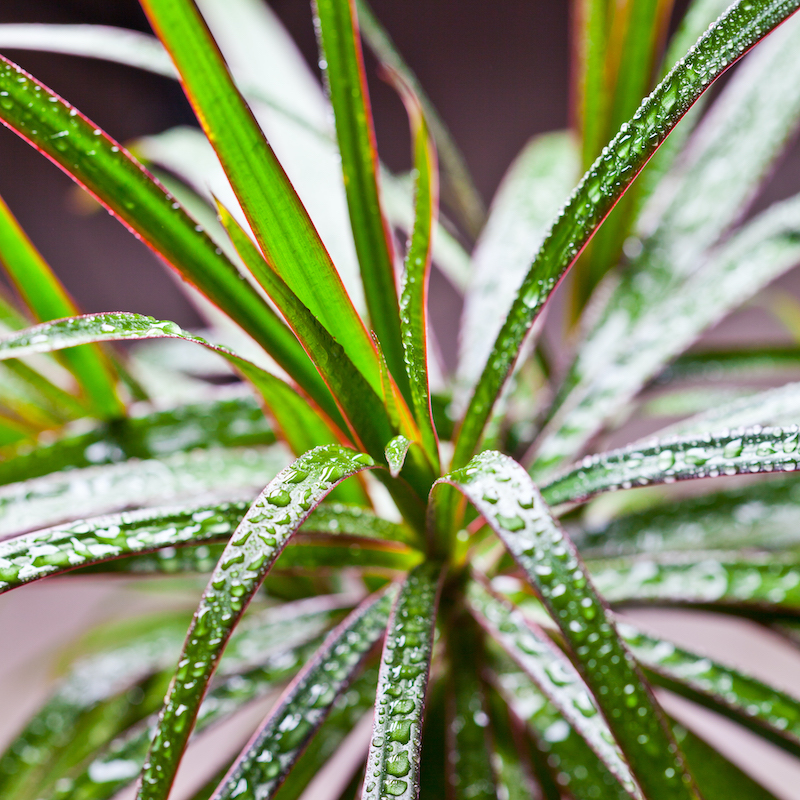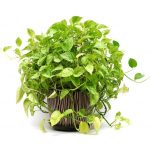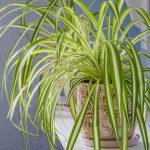
With tall stems and long thin leaves, the Madagascar dragon tree or red edged Dracaena, is a strikingly beautiful feature plant and dragon tree care is relatively simple. The dragon tree is perfect for a family room or lounge room corner where it will reach up rather than out. It will grow in low light or bright, indoor light and is a house plant that has been popular for many years, probably due to its hardy nature. There are a variety of leaf colours available to suit your decor and the dragon tree is also on NASA’s list of top air purifying plants so it will help freshen the air!
Often referred to as a red edged Dracaena, a small Madagascar dragon tree begins as a tuft of long, slender leaves close to the soil surface. As the plant grows the stem, also known as a cane, stretches up and the lower leaves eventually drop off creating a bold and attractive focal point in your home. The cluster of leaves on top of the long thin cane is quite architectural and stunning as a decorative house plant. The tall, narrow stem is perfectly suited to a family room or hallway where it won’t be in the way of passing traffic. Despite their appearance, the dragon tree leaves are quite soft and not damaginly spikey to passer-bys.
 |
 |
 |
 |
| Light | Water | Ease of Growing | Growth Rate |
| Indirect light to low light Avoid direct sunlight | Keep moist, but not waterlogged Avoid overwatering | Very easy, great for beginners | Slower, but long living |
- D. marginata – the original Dracaena tree with green leaves rimmed in deep red
- D. marginata ‘tricolor’ – the main leaf has green and yellow stripes with the characteristic red edges
- D. marginata ‘colorama’ – this is a truly unique dragon tree with the red edges being the dominant leaf colour creating a leaf that is more red than green
- D. marginata ‘tarzan’ – this variety is like the original one in colour but the leaves are more clustered at the top of the cane creating a pom-pom look
Madagascar Dragon Tree Care Guide
Light
For optimal growth your red edged Dracaena will prefer to be in a spot resembling light shade. It will grow in low light areas of your home, but avoid exposing it to direct sunlight. To encourage straighter growth it is recommended that you rotate your plant, with a quarter turn, each week to avoid it bending towards the light.
Water
Although your dragon tree can tolerate a little neglect, it will be healthier with regular watering, just to keep the soil moist. Don’t allow it to dry out too much and avoid overwatering it. Be sure that the soil allows the water to drain away easily so the soil doesn’t become waterlogged. And in winter, your red-edged Dracaena will require even less water.
Temperature and Humidity
Dragon plant care is quite simple in terms of temperature and humidity. If you are comfortable in your home, it probably is too The Madagascar dragon tree is one of the Dracaenas that is most able to tolerate cooler temperatures in winter, around 50°F (10°C). Its ideal growing temperature range is between 60°F – 80°F (16°C – 26°C). The dragon tree prefers to have the humidity on the higher side, so perhaps give it a misting if the humidity is lower in your home.
Fertilizer
It’s a great idea to feed your dragon tree during the spring and summer with an all purpose indoor plant fertilizer. This will encourage the growth of new leaves when it is actively growing.
Pruning
The only pruning that is required is to remove old leaves as they yellow and droop and if you need to reduct the height of your plant you can prune the entire top off and replant it as explained in the Propagation section below. If your Dracaena marginata grows new branches out the side you may like to prune these and regrow them to maintain the plants shape.
Madagascar Dragon Tree Planting Guide
Soil
Being such an easy to care for house plant, your dragon tree care does not require any particular soil type, just an all-purpose potting mix that is well-draining will do the job.
Repotting
To allow your red edged Dracaena to grow taller, it will be necessary to provide it with a larger pot, about every 2 years. Spring or summer is the best time to repot your dragon tree plant, when the weather has warmed up. When you repot your plant it’s a good time to trim any large, entangled roots back as the roots do grow quite vigorously. Repot your dragon tree into a pot that is slightly larger with good drainage.
Propagation
Dracaena propogation is quite easy and similar for different types of Dracaenas. There are three main ways to propagate your dragon tree.
- Remove the crown – if your dragon tree plant is too long and lanky, simply cut the stem at the height you would like to maintain it at. The cut stem will soon regrow.
- Replant the crown – The piece you have removed can be placed in potting mix and will also regrow. You can use a rooting hormone to encourage new roots and it’s best to keep it warm, perhaps with a heated grow mat.
- A 2″ – 3″ (5cm – 7.5cm) piece of the cane can also be used to regrow a red edged Dracaena. Be sure to keep the cut cane upright in the correct direction for growth (it may be helpful to mark the top end when you cut it). The cane can be placed upright in soil or be laid horizontally across the soil and half buried. For an upright cutting be sure to have the bottom in the soil and for a horizontal cutting be sure to face any leaf nodes up. Sometimes the bottom of the end can also be placed in water to grow roots and then transplanted to soil.
Common Madagascar Dragon Tree Problems
With the right dragon tree care you should not have too many problems with pests or disease. A few thing to watch out for are:
Spider mites – if you notice webbing around the base of the leaves, these insects could be the cause and will usually only cause problems if the humidity is quite low. Simple mist your plant regularly and remove visible spider mites or you can use a insecticide.
Yellowing lower leaves – as leaves age they will turn yellow and fall off. As long as this is happening slowly, over time this is a normal part of the plants growth and is no need for concern.
Leaves with brown tips and yellow edges – this could indicate that the air is too dry or cold drafts could be the cause. If your leaves also have brown spots on them, underwatering could be the problem.
Leaves soft and curled with brown edges – could indicate your plant is too cold.
Leaves with bleached or scorched patches – could be due to excessive sunlight and it would be best to reduce the light your dragon tree plant is receiving.
Particularly small new leaves – it may be because the plant is not receiving enough light. During the growing season, perhaps move your red edged Draceana so it receives more light.
Soft, mushy canes – would indicate that your plant is suffering from overwatering. It is not likely that your plant will recover, but if part of the cane is still firm it could be cut and try propagating it following the above instructions.
Toxicity
The sap of the Madagascar dragon tree is mildly toxic and may cause skin irritation and digestive tract irritation if ingested by pets (particularly cats as they are attracted to the slender foliage) or people.
Summary of Dragon Tree Care
Do’s:
- avoid overwatering
- occasionally wipe dust off the leaves or take it outside and gently spray with water to remove dust.
Don’t:
- don’t expose it to hot sunlight
- don’t let it get too cold
Interesting Facts
- Top rated air purifying plant by NASA
- has remained popular as a house plant since the 1960’s
If you love house plants the Madagascar dragon tree (Dracaena marginata) is a great plant to add to your urban jungle. Its stunning, architectural growth makes it a focal point in any home and it can be neatly positioned to avoid being in the way of family members. Best of all the simple dragon tree care makes it a easy, nearly indestructible house plant for indoor gardening beginners and house plant enthusiasts.







